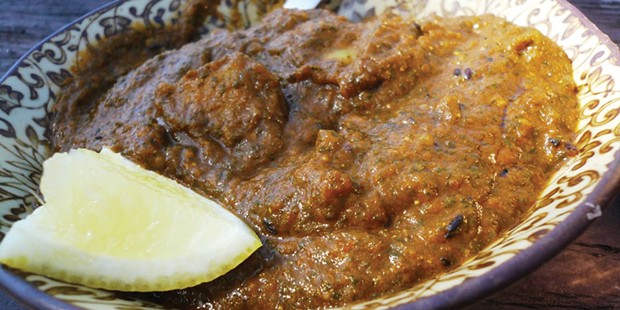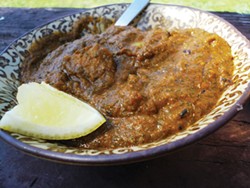[
{
"name": "Top Stories Video Pair",
"insertPoint": "7",
"component": "17087298",
"parentWrapperClass": "fdn-ads-inline-content-block",
"requiredCountToDisplay": "1"
}
]
Ever since we were kids, when springtime came around, my brother and I would browse patches of wild mustard greens while out in the fields. The spicy, sharp flavor always reminds me of days in the old orchards. While these greens are delectable sautéed with onion and bits of bacon as a side dish to a roast chicken or a fillet of fish, one of my all-time favorite ways to prepare mustard greens is in a traditional Indian curry called saag.
This dish consists of a greens-based curry infused with tomato, onion and a broad array of spices. Typically saag will either contain chicken or paneer, a fresh farmer's cheese, though I have enjoyed using wild-harvested small game as well. In most parts of India, saag is made with spinach, however, in certain regions where mustard is grown for its seeds for making cooking oil, the leaves are often substituted for spinach. While wild mustard is not native to California, it's one of the most common plants I encounter on walks, and since spinach is the most expensive ingredient in a good saag, making this dish with wild mustard is fun, easy and free. As an added bonus, it is absolutely delicious.
Keep in mind that while mustard is used in cuisines throughout the world, some people experience slight allergies to it. As with any new food in your diet, always try a small portion the first time and take note of how it affects you before diving in and eating three plates of curry.
Wild mustard can be easily identified by characteristic features such as its distinct cluster of bright yellow flowers in contrast the emerald green leaves and light green stalk in the spring. The leaves of the mustard plant are toothed and somewhat lobed, and seeds can be found developing in small pods all along the top of the stalk just below the flowering head. Crush a leaf and smell it, then give it a nibble. The aroma and flavors are distinct and reminiscent of horseradish.
When seeking out a stand of wild mustard to harvest, consider the following. First, the environment the mustard grows in will vary. Significant small-leaf bearing plants can be found on the sand bars of the Mad River, though larger leaf-bearing subspecies will be found in darker wet soils in full sun along meadows, such as in the Arcata Bottoms. Second, when harvesting you must be respectful of private land. Trespassing is no joke, though many landowners are more than happy to accommodate a forager looking to eat a few of the "weeds" growing in his or her pastures. Third, it is important to consider possible contamination when you are planning to harvest any wild edible, as many areas may be polluted or sprayed with herbicides and pesticides. Roadsides, vacant lots and areas around power lines and power poles should be avoided. Once a patch has been located, wear gloves when harvesting, as the mature leaves will be covered by coarse, prickly hairs. These spiky hairs quickly wilt when blanched in boiling water, so both young and mature leaves are perfectly suitable for making a good saag.
Wild Mustard
Saag Paneer
Making the curry takes roughly 45 minutes but the paneer, for which you will need a cheesecloth, must be made a few hours ahead. Serves four.
For the curry:
1 pound wild mustard leaves
4 tablespoons vegetable oil or ghee (Indian clarified butter), divided
1 14-ounce can chopped tomatoes
1 yellow onion, diced
1/8 cup heavy cream
2 tablespoons garam masala
2 tablespoons ground cumin
2 tablespoons ground coriander
1 tablespoon turmeric powder
Chili powder to taste
Salt to taste
For the paneer:
1 gallon whole milk
Juice of two lemons
First, make the paneer. Pour the milk into a pot and heat it to a low boil. Add the lemon juice and stir slowly. When the curds separate from the whey (which will turn greenish yellow from the added juice), pour the contents through a fine wire strainer and place the curds on a cheesecloth. Bundle up these curds in the cheesecloth and place it in a bowl with a heavy can or plate on top of the bundle to press out extra moisture. Place it in the refrigerator for at least 2 hours ahead of time when planning your saag. I find making the paneer the night before streamlines the process and allows ample time for this delicious farmer's cheese to firm up. Once the paneer is a single solid block, cut it into ½-inch cubes.
Now prepare the saag. Blanch the mustard greens in boiling water for at least 3 to 5 minutes. Then puree the leaves in a food processor until they have a smooth consistency. A little water may be added if needed. In a large saucepan, heat 3 tablespoons of oil or ghee and add the garam masala, cumin, coriander, turmeric and onion. Sauté until the onion is translucent.
In a separate pan, add 1 tablespoon oil or ghee and sear the paneer cubes on all sides over medium-high heat so they are slightly golden brown. Paneer will not melt, so do not worry. Set the browned paneer aside.
Add the tomatoes to the spices and onion, and sauté 5 minutes. Now add the pureed mustard greens. Cook them an additional 2 minutes. Add the paneer and gently stir until all the cubes are coated with gravy so that the flavors are fully absorbed. Simmer for 15 minutes longer before gently stirring in the cream, chili powder and salt to taste. Serve over steamed basmati or jasmine rice.
Comments
Showing 1-1 of 1
more from the author
-
A Fish in Every Pan
Taiwanese panfish and cucumber salad
- Nov 9, 2017
-
Panfish Fishing
Teach someone to fish (and clean)
- Nov 9, 2017
-
Catch of the Day
The Sea Forager's Guide by Kirk Lombard
- Oct 19, 2017
- More »

































